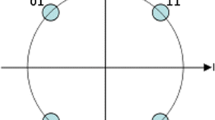Abstract
We propose a new method of designing super-orthogonal space-time trellis codes (SOSTTCS) by labeling each state transition of the trellis diagram with an ordered pair of 2×2 orthogonal matrices instead of only a single 2×2 orthogonal matrix. An 8D instead of a 4D signal constellation is thus used for modulation and the delay elements of the trellis encoder are 4T instead of 2T, where T is the 2D symbol duration. Therefore, at the receiver, the sequence decoding using Viterbi algorithm requires two times less frequent updating of the branch metrics. We investigate by computer simulation the performance of the new sosttcs compared to sosttcs designed by the known method. The frame error rate (fer) and the bit error rate (ber) simulation results show that the performance of the new sosttcs is practically as good as that of the sosttcs of similar complexity designed along classical lines, with the advantage that the number of arithmetic and logic operations performed by the decoder per time unit is smaller, which is crucial in high data-rate applications.
Résumé
Nous proposons une nouvelle méthode pour concevoir des codes espace-temps superorthogonaux (sosttcs) en étiquetant chaque transition du diagramme en treillis par une paire ordonnée de matrices orthogonales 2×2 à la place d’une seule matrice orthogonale 2×2. On emploie donc pour la modulation une constellation de signaux 8D à la place d’une 4D, ce qui fait que les éléments de retard sont 4T à la place de 2T, où T est la durée d’un symbole. Pour cette raison, au récepteur, le décodage séquentiel utilisant l’algorithme de Viterbi demande une actualisation deux fois moins fréquente des métriques de branche. Par simulation au moyen d’un ordinateur, nous étudions la performance de nos nouveaux codes en treillis espace-temps super-orthogonaux en les comparant aux codes conçus par la méthode connue. Les résultats des simulations concernant le taux d’erreurs de trames et le taux d’erreurs de bits (teb) montrent que la performance de nos nouveaux codes espace-temps super-orthogonaux est, d’un point de vue pratique, aussi bonne que celle des codes de complexité similaire conçus de manière classique, avec l’avantage d’un nombre réduit d’opérations arithmétiques et logiques à effectuer par le décodeur par unité de temps, ce qui compte le plus dans les applications à débit élevé.
Similar content being viewed by others
References
Tarokh (V.), Seshadri (N.), Calderbank (A.R.), Space-time codes for high data rate wireless communications: Performance criterion and code construction, IEEE Trans. Inform. Theory, 44, pp. 744–765, 1998.
Ungerboeck (G.), Channel coding with multilevel/phase signals, IEEE Trans. Inform. Theory, 28, pp. 55–67, 1982.
Alamouti (S.M.), A simple transmit diversity technique for wireless communications, IEEE j. Select. Areas Commun., 16, pp. 1451–1458, 1998.
Siwamogsatham (S.), Fitz (m. p.), Robust space-time coding for correlated Rayleigh fading channels, IEEE Trans. Signal Processing, 50, pp. 2408–2416, 2002
Ionescu (M.), Mukkavilli (K.K.), Yan (Z.), Lilleberg (J.), Improved 8- and 16-state space time codes for 4psk with two transmit antennas, IEEE Commun. Lett., 5, pp. 301–305, 2001.
Siwamogsatham (S.), Fitz (M. P.), High-rate concatenated space-time block code m-tcm designs, IEEE Trans. Inform. Theory, 51, pp. 4173–4183, 2005.
Ionescu (D.M.), On space-time code design, IEEE Trans. Wireless Commun., 2, pp. 20–28, 2003.
Jafarkhani (H.), Seshadri (N.), Super-orthogonal space-time trellis codes, IEEE Trans. Inform. Theory, 49, pp. 937–950, 2003.
Divsalar (D.), Simon (M.K.), The design of trellis coded mpsk for fading channels: Performance criteria, IEEE Trans. Commun., 36, pp. 1004–1012, 1988.
Sterian (C.E.D.), Singh (H.), Pätzold (M.), Hogstad (B.O.), Super-orthogonal space-time codes with rectangular constellations and two transmit antennas for high data rate wireless communications, IEEE Trans. Wireless Communications, 5, pp. 1857–1865, 2006.
Sterian (C.E.D.), Linga (S.), Singh (H.), Pätzold (M.), New super-orthogonal space-time codes with 32qam and two transmit antennas for five bits per signaling interval, accepted for publication in European Trans. Telecommunications.
Jafarkhani (H.), Hassanpour (N.), Super-quasi-orthogonal space-time trellis codes for four transmit antennas, IEEE Trans. Wireless Commun., 4, pp. 215–227, 2005.
Author information
Authors and Affiliations
Rights and permissions
About this article
Cite this article
Sterian, D., Enescu, A.A. & Bănică, I. Super-orthogonal space-time trellis codes with eight dimensional phase-shift keying signal constellations. Ann. Telecommun. 62, 486–512 (2007). https://doi.org/10.1007/BF03253271
Received:
Accepted:
Issue Date:
DOI: https://doi.org/10.1007/BF03253271
Key words
- Treillis coding
- Phase shift keying
- Signal set
- Time space
- Space diversity
- Coded modulation
- Orthogonal signal
- Matrix method
- Viterbi decoding




